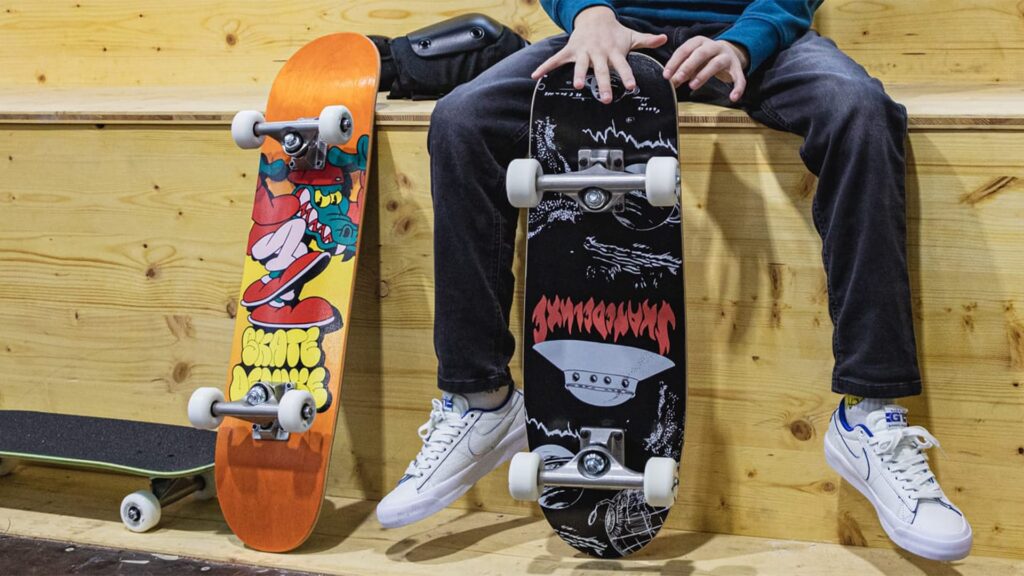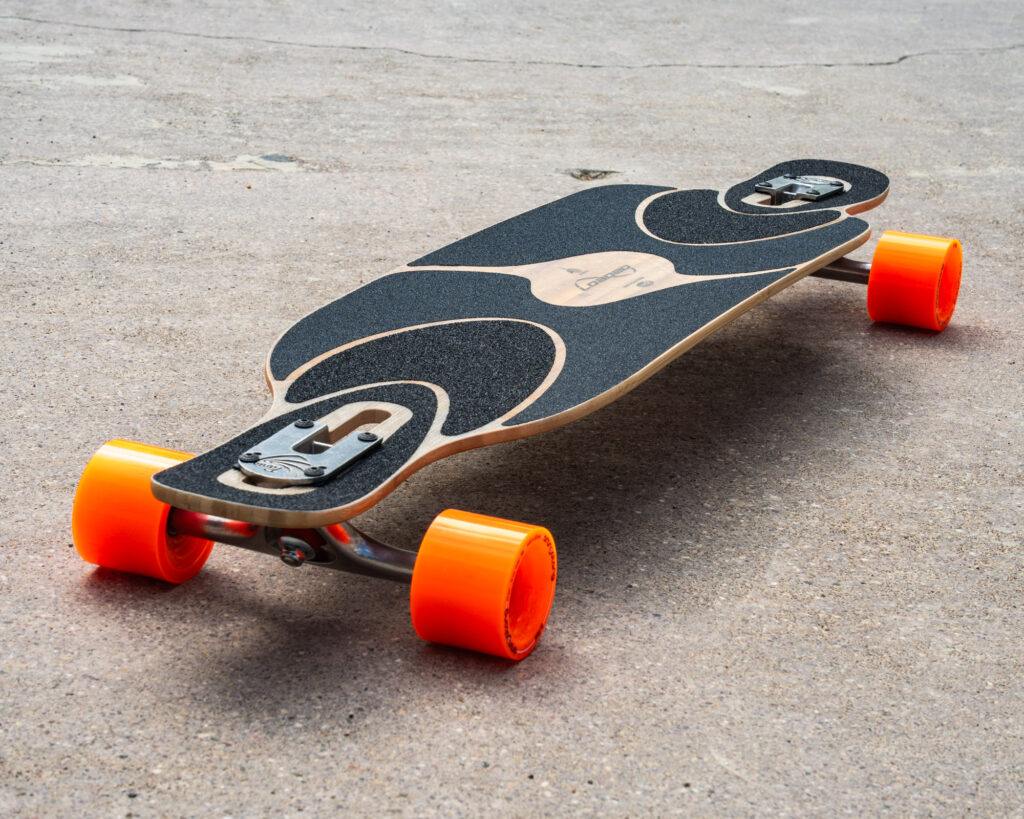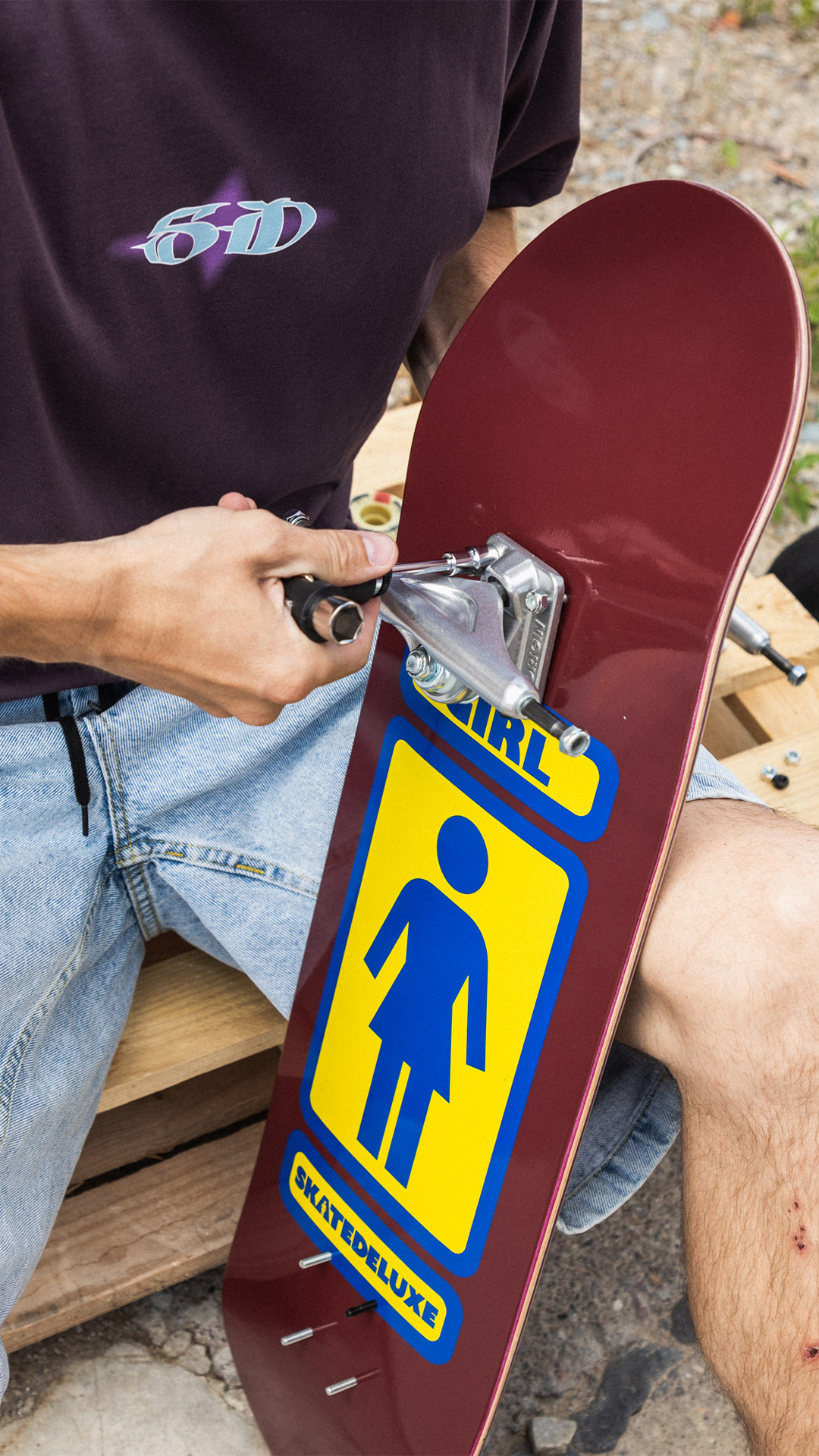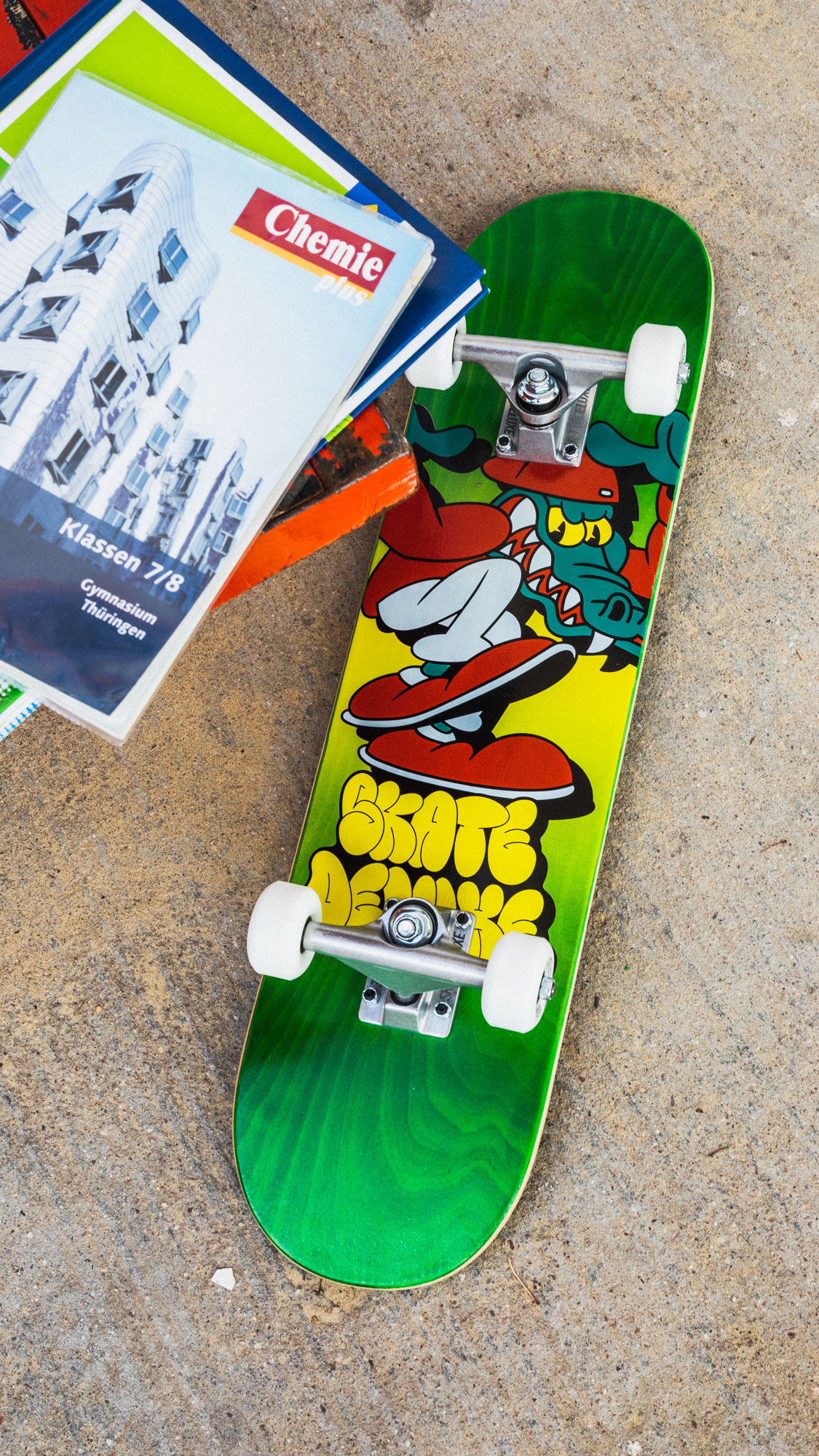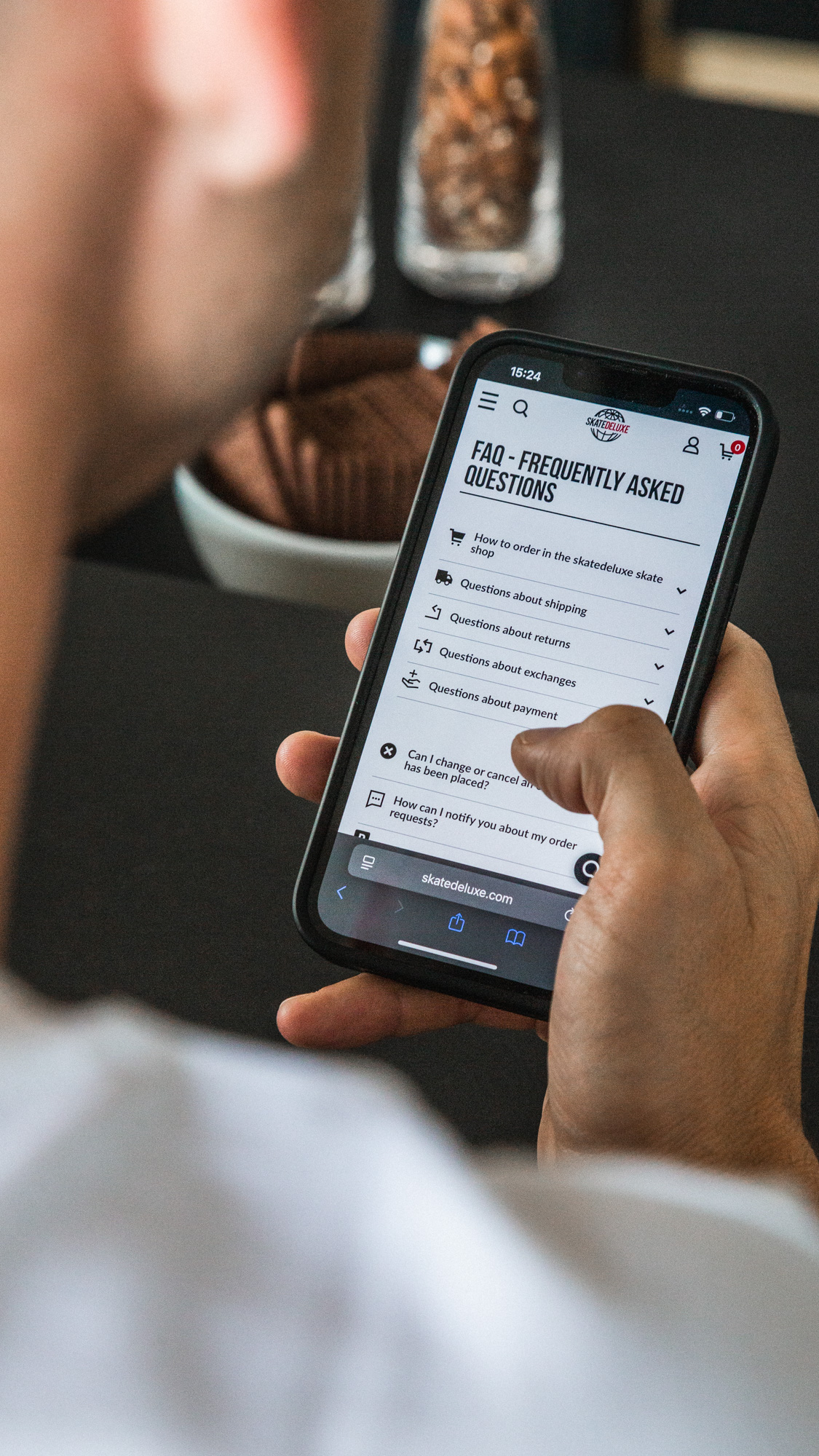Finding the right first skateboard can be tricky, especially when you’re just starting out. To make the process easier, here are some helpful tips to understand what to look for when buying your first skateboard.
- 1. Skateboards for Beginners – what should you consider?
- 1.1 What types of skateboards are there?
- 1.2 Size recommendations – deck
- 2. Complete skateboards or a custom setup?
- 2.1 Complete boards
- 2.2 Your first skateboard at the best price
- 2.3 Your custom skateboard with the Skateboard Configurator
- 3. Use cases – which board do I need for park, street, or transition?
- 3.1 Park skating | All-round
- 3.2 Street
- 3.3 Halfpipe | Bowl | Ramp | Transition
- 4. Helpful accessories – what do you need besides a skateboard?
- 4.1 Protective gear
- 4.2 Tools
- 5. More info about skateboards
Skateboards for Beginners – What should you consider?
Although the individual parts of a skateboard hardly differ at first glance, there are a few things to consider so you can find the right complete skateboard that is tailored to your needs. There are different types of skateboards that are designed for different terrains. Which skateboard is right for you depends on where and how you want to skate.
If you want a deeper understanding of the components of a typical skateboard, take a look at our skateboarding glossary.
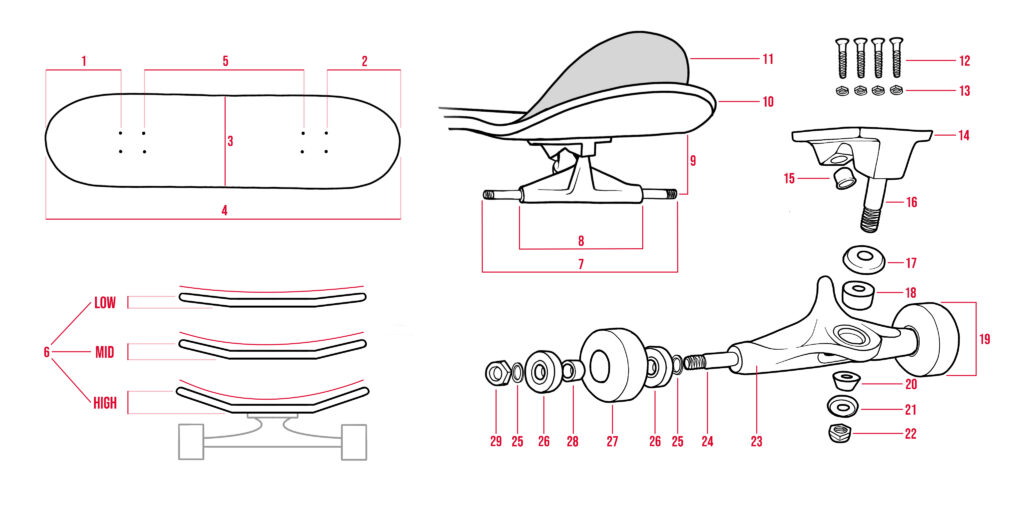
1: Nose
2: Tail
3: Deck width
4: Deck lenght
5: Wheelbase
6: Concave
7: Truck width (outer)
8: Hanger width (inner)
9: Truck height
10: Deck
11: Griptape
12: Mounting bolts/screws
13: Nuts
14: Baseplate
15: Pivot Cup
16: Kingpin
17: Bottom Washer
18: Bottom Bushing
19: Wheel size/diameter
20: Top Bushing
21: Top Washer
22: Kingpin-nut
23: Hanger
24: Axle
25: Speed ring
26: Bearings
27: Skateboard Wheel
28: Spacer
29: Axle nut (on the wheel)
What types of skateboards are there?
In principle, skateboards share the same basic construction. Depending on the use case, there are differences in the shape and specs of the individual parts. The deck is especially crucial here. Broadly speaking, skateboards can be categorized into “classic” skateboards, cruisers, and longboards.

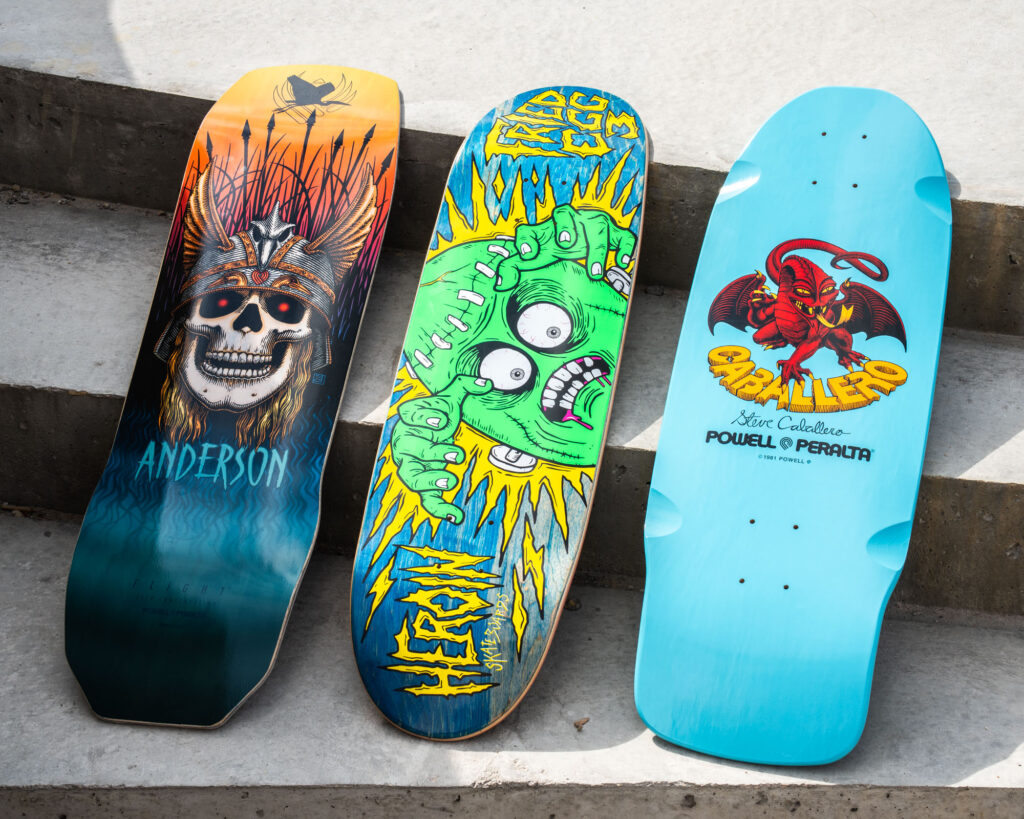
Shaped decks
Unlike popsicle decks, shaped decks do not have a uniform shape. They are often characterized by special shapes of the nose or tail, which are angular, pointed or otherwise “shaped”. You can also do and learn many tricks with shaped decks. However, we recommend a popsicle shape at the beginning.
You can use our Skateboard Configurator to build complete boards from all the popsicle and shaped decks shown above. You’ll also find all other decks from our assortment there.

Cruisers
Cruiser skateboards differ from normal skateboards in length, width and shape. What makes them special are the soft wheels and the relaxed cruising experience. They are perfect for getting from A to B in the city. Cruisers are usually completely assembled and “Ready To Skate”. If a longboard is too big for you or isn’t suitable for style reasons, then a cruiser is the right thing for you.
Size recommendation – deck
When talking about the size of a skateboard deck or a skateboard, it’s usually the width that’s being referred to. The length can also play a role, but the deck width is more important at the beginning. Over time you’ll find out which width suits you best. Of course, your personal preference also determines how wide or narrow or short or long your board should be. In addition, trends in skateboarding mean that certain sizes or shapes are preferred.
Size chart
For starters, your height and shoe size are good guidelines to find the right deck for you. Take a look at the table and find the right width and length. Skateboard dimensions are always given in inches [″]. One inch corresponds to 2.54 cm.
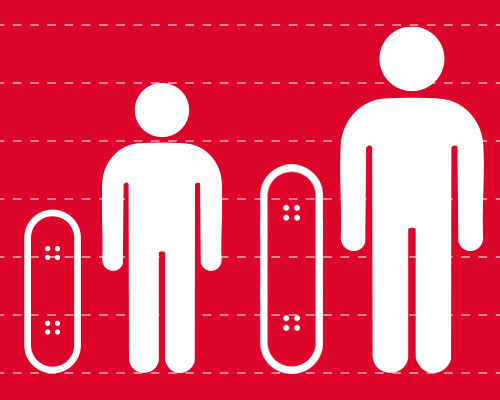
| Shoe size – Deck width | Height – Deck length |
| US 1 | EU 31.5: < 7″ – 7.25″ | < 100 cm: < 28″ |
| US 5 | EU 36.5: 7.625″ – 8″ | 100-125 cm: 28″ – 30.5″ |
| US 7 | EU 40: 7.875″ – 8.125″ | 125-140 cm: 28″ – 30.5″ |
| US 9 | EU 42.5: 8.00″ – 8.375″ | 140 – 175 cm: 30.5″ – 31.875″ |
| US 10 | EU 44: 8.125″ – 8.5″ | 175 – 190 cm: 31.875″ – 32.25″ |
| US 12 | EU 46: 8.375″ – 8.625″ | > 190 cm: > 32.5″ |
Complete skateboards or a custom setup?
The components of your skateboard need to be matched to each other. For example, not all skateboard trucks fit every deck. Complete skateboards give you the confidence that all components – like trucks, deck, and wheels – perfectly match in size and dimensions. If you don’t want to build your own setup and prefer to start riding right away, a complete board is a solid choice.
Complete boards
The components of your skateboard have to fit together. For example, not all skateboard trucks fit on every deck. If you don’t want to put together your own skateboard setup, but want to get skating right away, we recommend that you buy a complete skateboard.
The complete boards in the skatedeluxe skate shop are high quality, already pre-assembled and therefore ready for skating. Since they’re beginner models, these skateboards make sense because they’re a little cheaper. Best you start with a skatedeluxe complete sk8boards – here both quality and price are right!

Your individual skateboard with the skateboard configurator

With the help of the skatedeluxe skateboard configurator, you can put together your own skateboard in just a few steps. This makes sure that parts such as the deck, trucks, wheels, etc. definitely fit together and at the same time, you’ll get useful tips while creating your own skateboard setup. Simply select the components, check recommendations and information and order your individual skateboard.
Skateboards by terrain
When choosing your setup, you should consider what style of skating you’ll ultimately want to focus on. If you already know where your preferences lie or if you’re simply looking for an all-round setup, you can consider the following recommendations. As mentioned before, these are just recommendations – not requirements. For park, street, and transition, you’ll find our recommendations here for the right combination of deck, trucks, and wheels.

Skatepark / Allround
If you want to skate in skate parks or leave all your options open, we recommend an all-round skateboard setup. Different deck widths naturally have different attributes.While narrow decks are manoeuvrable and easy to flip, wide skateboards have the advantage of offering more space to stand and land. The best thing to do is to check our overview and think about what’s important to you.
Mid or standard trucks are best suited for your all-round setup. You’ll want to choose slightly softer, medium-sized wheels between 52 and 56 mm for this setup; this increases the grip on what are usually very smooth surfaces in skateparks.Depending on your preference, you can also install shock or riser pads to increase smoothness. When you start practising on ramps, you should definitely wear protective gear.
Deck: From wide to narrow, anything is possible here
Trucks: Mid or High
Wheels: 52 mm – 56 mm, ≥ 98A
Bearings: skatedeluxe Blacks, Bones Reds
Shock pads: optional
Bolts: short (7/8″ – 1″ | longer accordingly, if you use shock pads)
Protection: suggested
For starters, we’ve put together an all-round skateboard in our configurator based on our recommendations. You can customize every component to your liking.
To get started, we also have some great complete boards that you can order, already assembled and ready to skate!
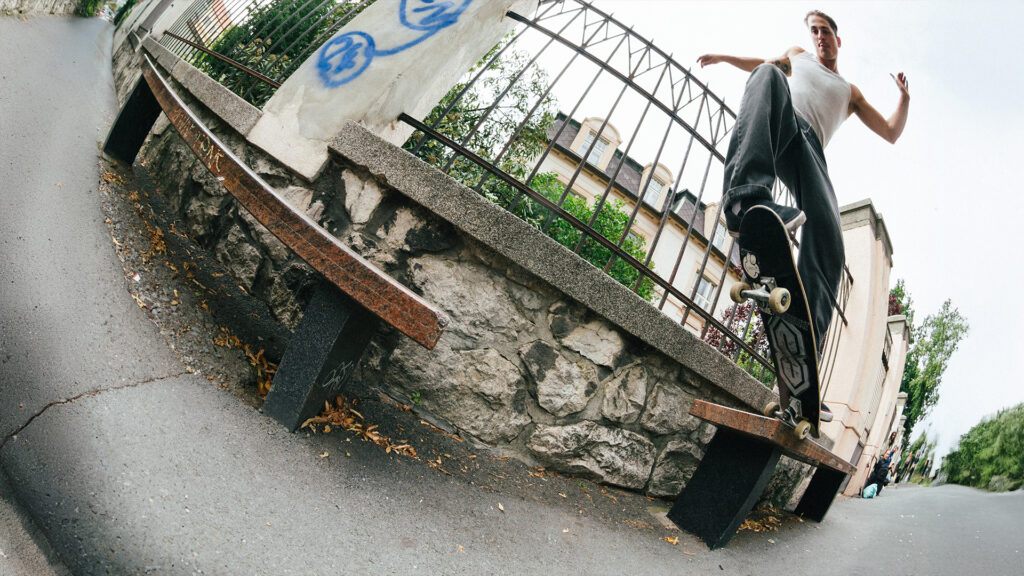
Street
You and your board belong on the street? Then it’s best to go with a skateboard from this category. As its name suggests, street skating obstacles are found on the street or in public, e.g. benches, stairs, railings, etc. Many street skaters tend to have narrower decks because they are easier to flip than wide boards and are generally very agile.
Low and mid trucks are best suited for this style. These are also available in light versions with a hollowed-out kingpin or axle pin and are screwed to your deck using a short assembly set (7/8 ″ – 1 ″). What you save in weight, you theoretically gain in height on ollies and flips.
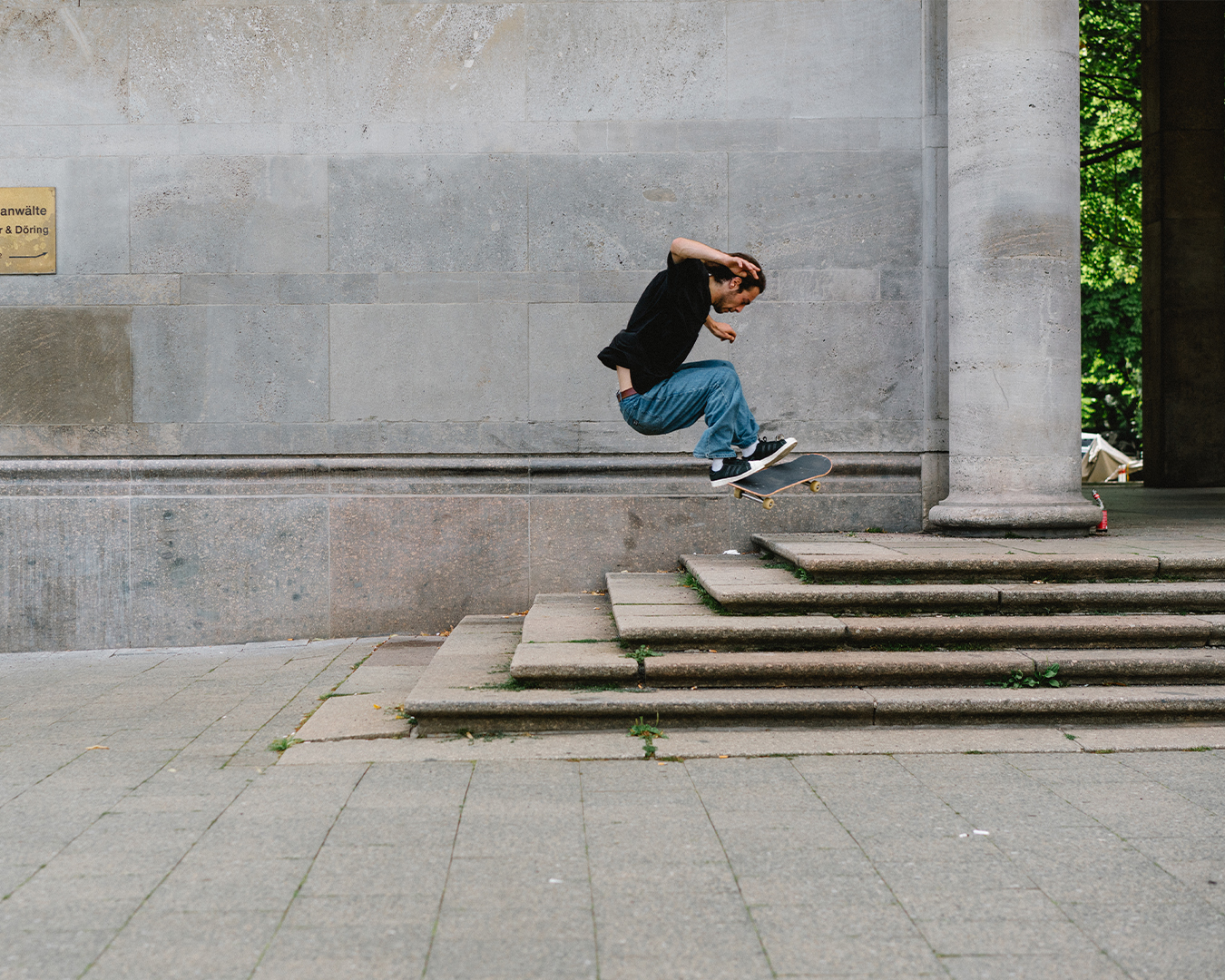
For grinds and slides, it’s best to choose hard wheels starting from 100A; small wheels are normally used for street skating since they accelerate faster and are more manoeuvrable. However, if you’ll be skating rough spots with rugged surfaces, your wheels shouldn’t be too small because the smallest stone can bring your wheels to a sudden stop, causing you to kiss the concrete.
When selecting your bearings, stick to models that are durable and resilient to the dirt on the streets. Tip: you should always have some skate wax around for curbs and rails.
Deck: rather narrow decks that are agile and flip easily
Trucks: Low or Mid
Wheels: 50 mm – 53 mm, ≥100A
Bearings: skatedeluxe Blacks, Bones Reds
Shock pads: optional
Bolts: short (7/8″ – 1″)
We’ve also put together a street skateboard in our configurator based on our recommendations. You can customize every component to your liking.
Don’t want to deal with the all the different individual components of your skateboard? Don’t sweat it! We also offer a selection of complete skateboards that’ll be shipped to you ready to skate!
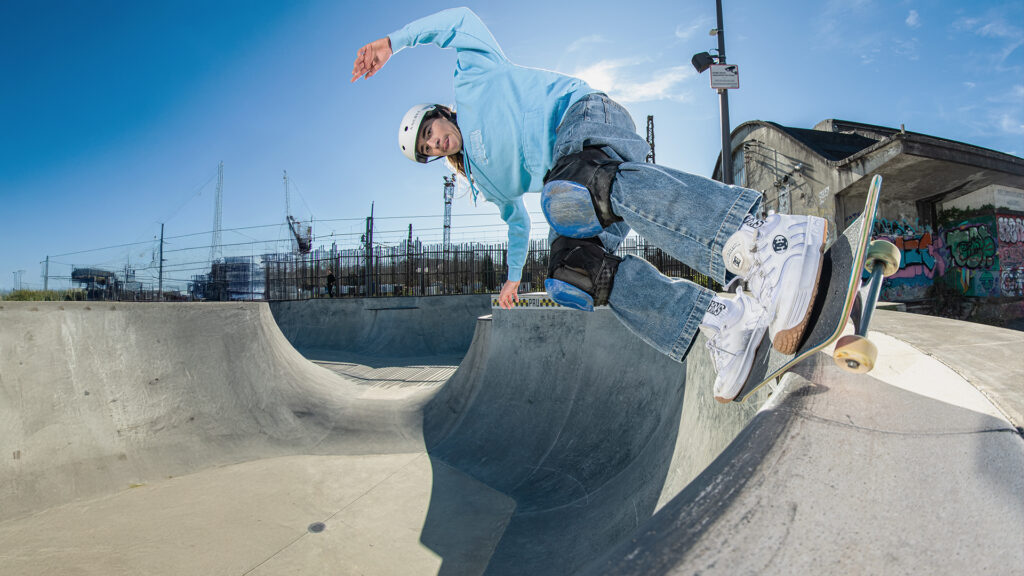
Halfpipe | Bowl | Ramp | Transition
We recommend wider skateboards for skating in ramps and bowls. Wide decks give you more space to stand, which will pay off at high speeds and airs. In addition, wheels with a larger diameter are used in transition skating because they maintain high speeds for longer.
For a bit more grip, softer wheels are recommended for a transition setup. When using big wheels, you should stick with mid or high trucks in order to prevent wheelbites. Riser pads and rails (plastic rails attached to the deck for increased stability during board and lip slides) are often used for this style of skating. Anyone who skates ramps should never skimp on protective gear.
Deck: wider decks for more space to land on
Trucks: Mid or High
Wheels: 53 mm – 56 mm, ≥ 98A
Bearings: skatedeluxe Blacks, Bones Reds
Shock pads: suggested
Bolts: longer (1″ – 1 1/4″ depending on the size of your pads)
Protection: suggested
Accessories: Rails (optional)
We’ve also put together a transition skateboard in our configurator based on our recommendations. You can customize every component to your liking.
Do you just want to keep it simple? We have a great selection of complete skateboards that can be delivered to your doorstep, ready to skate.
Protective gear in skateboarding? Definitely not uncool!
If you start skating, you won’t be able to avoid falling – unfortunately this is part of skateboarding. While experienced skaters know how to properly break a fall, helmets & protective gear protect you from injuries and help you get back on the board faster. Protective equipment is by no means uncool – professional skaters like Mark Gonzales or Lizzie Armanto prove just the opposite.
Protective gear

Stylish helmets for skating
Especially as a beginner, you should definitely wear a helmet. It protects you in case of serious falls. It’s crucial to wear a helmet, especially during your first visits to the skate park or when attempting a drop-in. In the skatedeluxe skate shop, you can expect a large selection and a lot of tips to help you find your skate helmet.
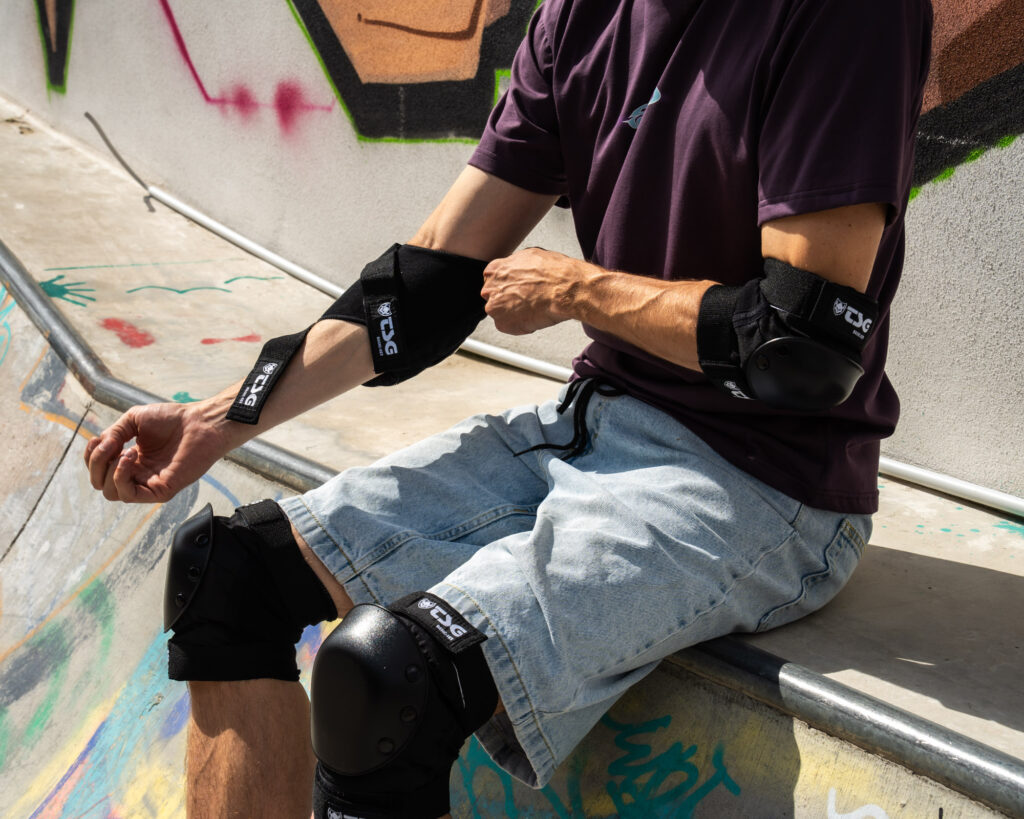
Protectors & protective equipment for skating
If you want to get back on the board quickly after a fall, we recommend wrist, elbow and knee protectors. Wearing protective clothing gives you safety during your first tricks and you will learn quickly. At skatedeluxe, you get individual skate protectors for hand, arm and leg or a complete set for all-around protection.
It is essential to ensure the protective clothing and helmets fit properly for maximum effectiveness. If they’re too tight, you won’t be able to move properly; if they’re too loose, they won’t help you in an emergency. You will find corresponding information on size selection on all product detail pages. Our size charts also give you an overview so that you can quickly find the right protectors for you.
Tools
More information about skateboards
If you want to learn more about skateboarding and the individual components such as decks, trucks and wheels, have a look at the skatedeluxe skateboard Wiki or watch the skatedeluxe Buyers Guide videos. As a beginner, you’ll get a load of skateboard knowledge and learn everything there is to know about the different parts of a skateboard.
Here are some topics we’ve put together that should be interesting for you. Want to know how to assemble your skateboard? Maybe you’re curious about how to learn your first tricks? Click through our wiki to learn everything about skateboarding.
Our customer service team is also available to you anytime if you want help selecting your first skateboard!
